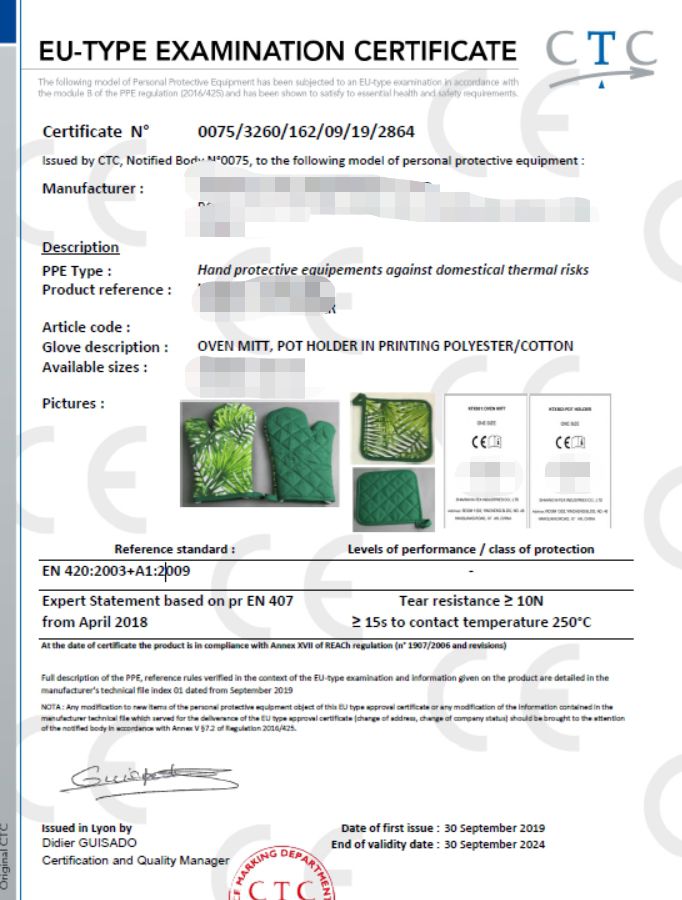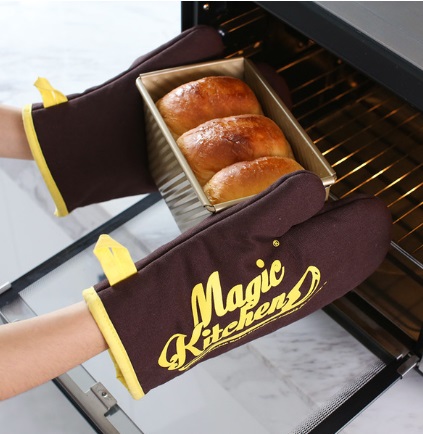Attention to Oven Mitts Manufacturers and Traders!
Oven mitts manufacturer,wholesale,factory have to provide CE certificate for oven mitt&oven glove from April , 2018.
INTRODUCTION
On March 9, 2016 Regulation 425/2016/EU was approved and it was published in the Official Journal of the European Union on March 31, 2016. This regulation will repeal and replace Personal Protective Equipment (PPE) Directive 89/686/EEC.
IMPORTANT DATES
- Directive 89/686/EEC is repealed with effect from April 21, 2018.
- Items (such as oven gloves and mitts) not previously certified will need to be withdrawn from sale before April 21, 2018
- EC type-examination certificates (Article 10) approved 89/686/EEC remain valid until April 21, 2023 unless they expire before that date.
EU TYPE-EXAMINATION CERTIFICATES
EU type-examination certificates will be issued under Module B in Annex V. These will have a validity of five years.
TECHNICAL DOCUMENTATION
The requirements of the technical file (Annex III) have been re-specified for oven gloves. This will include:
(a) A complete description of the PPE and of its intended use;
(b) An assessment of the risks against which the PPE is intended to protect;
(c) A list of the essential health and safety requirements that are applicable to the PPE;
(d) Design and manufacturing drawings and schemes of the PPE and of its components, sub-assemblies and circuits;
(e) The descriptions and explanations necessary for the understanding of the drawings and schemes referred to in point (d) and of the operation of the PPE;
(f) The references of the harmonised standards referred to in Article 14 that have been applied for the design and manufacture of the PPE. In the event of partial application of harmonised standards, the documentation shall specify the parts which have been applied;
(g) Where harmonised standards have not been applied or have been only partially applied, descriptions of the other technical specifications that have been applied in order to satisfy the applicable essential health and safety requirements;
(h) The results of the design calculations, inspections and examinations carried out to verify the conformity of the PPE with the applicable essential health and safety requirements;
(i) Reports on the tests carried out to verify the conformity of the PPE with the applicable essential health and safety requirements and, where appropriate, to establish the relevant protection class;
(j) A description of the means used by the manufacturer during the production of the PPE to ensure the conformity of the PPE produced with the design specifications;
(k) A copy of the manufacturer’s instructions and information set out in point 1.4 of Annex II;
PPE PRODUCTS INCLUDED
PPE is defined as equipment designed and manufactured to be worn or held by a person for protection against one or more risks to that person’s health or safety.
Under 89/686/EEC PPE for private use against heat (e.g. oven gloves and mitts) was excluded. This is now included.
As Category I products are limited to those which protect against contact with hot surfaces not exceeding 50 °C, oven gloves and mitts cannot be included in Category I and must be considered to be Category II. This will require a formal Conformity assessment as below.
CONFORMITY ASSESSMENT PROCEDURES
Category II
EU type-examination (module B) set out in Annex V, followed by conformity to type based on internal production control (module C) set out in Annex VI.
The protection against contact heat in particular is, of course, a key issue with oven gloves and mitts. Previously they would have had to meet national standards such as BS 6526:1998 as a matter of due diligence. In future, oven gloves will need to be tested against European and ISO Standards. Currently the most appropriate are EN 407 “Protective gloves against thermal risks (heat and/or fire)” and EN 420:2003+A1:2009 “Protective gloves. General requirements and test methods” and the recently harmonised test method standard ISO 12127-1 for Clothing to protect against heat and flame – Determination of contact heat transmission through clothing or constituent materials – Part 1: Contact heat produced by heating cylinder.
To test a domestic oven glove, whether double ended or single mitt style, the materials and the glove will need to be tested to the ISO standard which is more onerous than the old British Standard. Testing will be performed at 250C instead of 150C before and after multiple washing and the design will need to protect the back of the hand as well as the palm and fingers. This may mean changing the designs of the products from those previously produced to ensure, for example, the pockets on the ends of the double ended glove are deep enough to properly protect the back of the hand. This is especially so when considering that these tend to be a single size and will have to cater for larger hands.
Example of the CE certificate:

